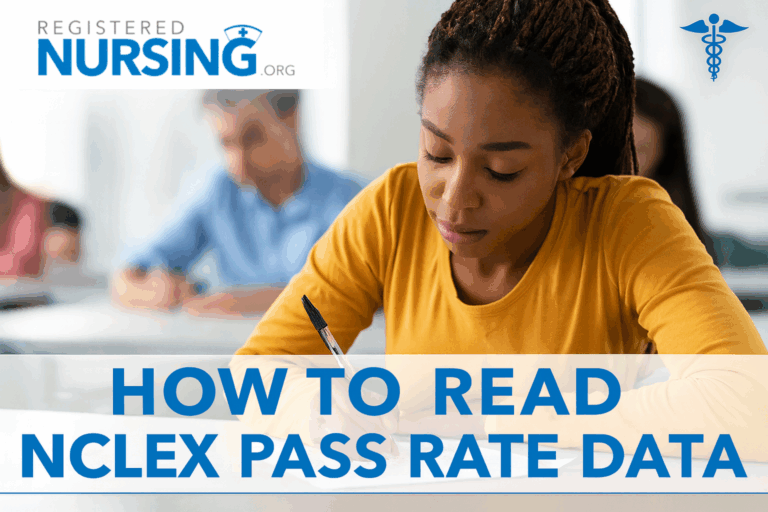How to Read NCLEX-RN Pass Rate Data When Evaluating Nursing Schools
- What the NCLEX-RN Pass Rate Measures
- First-Time Pass Rate vs. Overall Pass Rate
- How to Use Multi-Year Average Pass Rates
- Comparing Pass Rates to State and National Averages
- Understanding Cohort Size and Its Impact
- How Schools Influence Their Pass Rates (Both Positively and Negatively)
- NCLEX-RN Pass Rate Trends to Pay Attention To
- Using Pass Rates Alongside Other Program Quality Indicators
- Sample Checklist: How to Evaluate NCLEX-RN Data When Comparing Schools
- FAQs
- Latest Articles & Guides

Choosing the right nursing program is one of the most important decisions prospective RNs make, and the NCLEX-RN exam pass rate is one of the strongest indicators of a school's academic quality and graduate preparedness. But understanding what these numbers really mean (and what they don't) can be challenging. This guide explains how to interpret NCLEX-RN pass rates, how to compare schools, and the red flags to watch out for.
In this article, you'll learn:
- What NCLEX-RN pass rates actually measure
- The difference between "first-time" and "overall" pass rates
- How to compare schools using multi-year and statewide benchmarks
- Warning signs that a program's pass rate may not tell the full story
What the NCLEX-RN Pass Rate Measures
The NCLEX-RN pass rate reflects the percentage of a school's graduates who pass the national licensure exam. Most state boards publish first-time pass rates, which show how many graduates passed on their first attempt.
Why This Matters
A high pass rate usually signals:
- Strong curriculum and academic rigor
- Effective preparation for clinical judgment and test-taking
- Adequate faculty support and instructional quality
- Graduates who meet national standards for safe nursing practice
However, pass rates are only one piece of the puzzle. They must be interpreted in context.
First-Time Pass Rate vs. Overall Pass Rate
When evaluating a program, always check whether the pass rate refers to:
1. First-Time Pass Rate
The proportion of graduates who pass the NCLEX-RN the first time they take it.
This is the most important metric because it indicates how well the program prepares students without additional study or remediation.
2. Overall (or Cumulative) Pass Rate
The percentage of graduates who pass the NCLEX-RN eventually, regardless of the number of attempts.
Schools sometimes advertise overall pass rates because they appear higher. But a school with an 80% first-time rate and 100% cumulative rate may not prepare students as effectively as a school with a 95% first-time rate.
How to Use Multi-Year Average Pass Rates
A single year of pass rate data doesn't show the whole picture. Always look at 3–5 years of data to understand trends.
Example Comparison Table
| School | 2022 | 2023 | 2024 | 3-Year Average |
| School A | 95% | 93% | 96% | 94.7% |
| School B | 91% | 82% | 78% | 83.7% |
| School C | 88% | 90% | 87% | 88.3% |
How to Interpret This Table
- School A shows consistently strong outcomes.
- School B's decline may reflect curriculum changes, lower admission standards, faculty turnover, or student support gaps.
- School C is steady and reliable, though not quite as strong as School A.
Patterns matter more than any single number.
Comparing Pass Rates to State and National Averages
Pass rates are most helpful when compared against statewide and national benchmarks.
Typical Benchmarks
- National NCLEX-RN first-time pass rate: usually ranges around 78–82% (varies by year).
- State averages may be higher or lower depending on program quality within the state.
Why This Matters
A school with an 85% pass rate sounds strong, but if the state average is 92%, the program may be performing below par.
Conversely, a school with an 83% pass rate in a state where the average is 78% is outperforming peers.
RELATED: 10 Ways to Prepare for the NCLEX-RN Exam
Understanding Cohort Size and Its Impact
Cohort size affects how reliable a pass rate is.
Large Cohorts
- Provide more stable, reliable statistics
- Less likely to fluctuate year to year
Small Cohorts (10–20 students)
- A few students failing can drastically shift the pass rate
- Higher volatility year over year
- Look at 3–5 year averages for more accurate insight
Why This Matters
A program with 10 students and a 100% pass rate is not necessarily stronger than one with 200 students and a 94% pass rate.
How Schools Influence Their Pass Rates (Both Positively and Negatively)
Not all pass rates reflect student readiness alone; schools often take steps that influence outcomes.
Positive Influences (Good Signs)
- Comprehensive NCLEX prep and review courses
- Strong academic advising
- Early identification of at-risk students
- High standards for progression into clinicals
Negative Influences (Red Flags)
Some programs artificially boost pass rates through policies that reduce the number of students who reach graduation or NCLEX eligibility.
Common red flags include:
- High attrition rates (many students fail out before graduation)
- "Exit exams" that prevent weaker students from progressing
- Significant differences between enrollment and graduation numbers
- High pass rates paired with very small graduating classes
What to Look For
If a program admits 150 students but only graduates 30, even a 95% pass rate should be interpreted cautiously.
RELATED: NCLEX-RN Practice Test Questions
NCLEX-RN Pass Rate Trends to Pay Attention To
1. Trending Downward
Multiple years of decline may indicate:
- Faculty shortages
- Curriculum gaps
- Oversized cohorts
- Weak academic support
2. Trending Upward
Suggests program improvement or new investments in faculty, simulation labs, or NCLEX prep resources.
3. Sudden Spikes
A sudden jump from 70% to 95% may indicate policy changes—not necessarily academic improvement.
Using Pass Rates Alongside Other Program Quality Indicators
Pass rates should not be the sole deciding factor. Consider these additional metrics:
- Accreditation status (CCNE or ACEN)
- Approval status from the state board of nursing
- Clinical placement quality
- Faculty credentials and ratios
- Simulation lab quality and availability
- Graduation and job placement rates
- Student satisfaction scores
Pass rates are helpful, but only when placed in broader context.
Sample Checklist: How to Evaluate NCLEX-RN Data When Comparing Schools
Use this checklist to rate each nursing school you're considering:
Look for:
- First-time pass rate of 85–90% or higher
- Stable performance over 3–5 years
- Cohort sizes large enough to reflect accurate data
- Pass rates exceeding state and national averages
- Transparent reporting and no evidence of gatekeeping
Be cautious if you see:
- Big fluctuations year to year
- Extremely small graduating cohorts
- High attrition or unexplained student losses
- Pass rates far below state averages
- Lack of accreditation
FAQs
Q: Is a 100% NCLEX-RN pass rate always a good sign?
A: Not necessarily, but it can be. Very small cohorts or aggressive gatekeeping policies can artificially inflate pass rates. Look for multi-year stability and cohort transparency.
Q: What is a "good" NCLEX-RN pass rate?
A: A strong program typically maintains first-time pass rates of 85–90% or higher, especially if the state average is similar. Consistency over time matters more than any single year.
Q: Should I avoid schools with pass rates below the state average?
A: Not automatically. Some schools may be newer, expanding, or undergoing curriculum improvements. Review multi-year data and other indicators like accreditation, faculty qualifications, and clinical partnerships.
Q: Where can I find official NCLEX-RN pass rate data?
A: Most state boards of nursing publish annual pass rates for each program. You can also check CCNE, ACEN, or local regulatory agencies for approved schools and performance summaries.
Latest Articles & Guides
One of the keys to success as a registered nurse is embracing lifelong learning. Our articles and guides address hot topics and current events in nursing, from education to career mobility and beyond. No matter where you are on your nursing journey, there’s an article to help you build your knowledge base.
Browse our latest articles, curated specifically for modern nurses.



